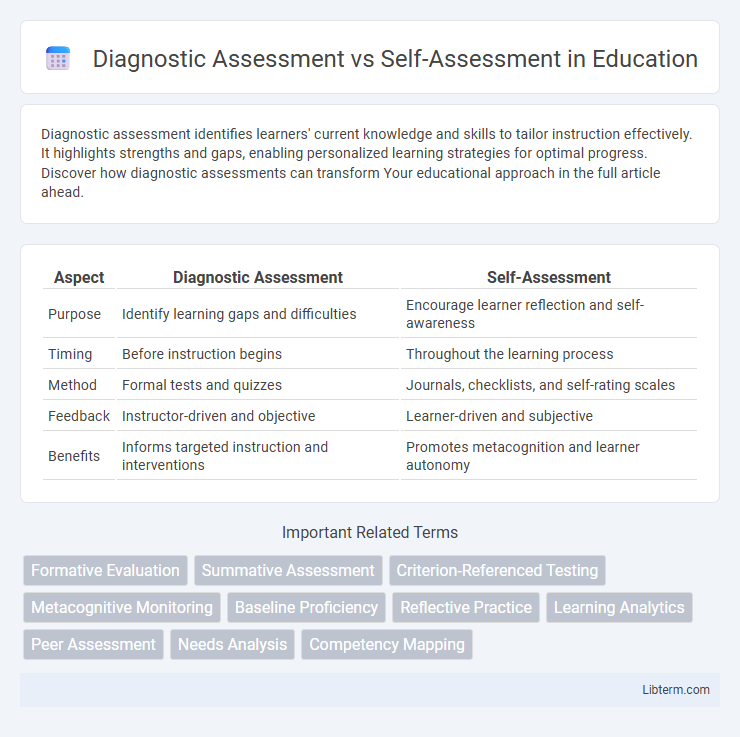Diagnostic assessment identifies learners' current knowledge and skills to tailor instruction effectively. It highlights strengths and gaps, enabling personalized learning strategies for optimal progress. Discover how diagnostic assessments can transform Your educational approach in the full article ahead.
Table of Comparison
| Aspect | Diagnostic Assessment | Self-Assessment |
|---|---|---|
| Purpose | Identify learning gaps and difficulties | Encourage learner reflection and self-awareness |
| Timing | Before instruction begins | Throughout the learning process |
| Method | Formal tests and quizzes | Journals, checklists, and self-rating scales |
| Feedback | Instructor-driven and objective | Learner-driven and subjective |
| Benefits | Informs targeted instruction and interventions | Promotes metacognition and learner autonomy |
Introduction to Diagnostic Assessment and Self-Assessment
Diagnostic Assessment identifies learners' existing knowledge and skill gaps before instruction begins, enabling targeted teaching strategies and personalized learning paths. Self-Assessment encourages students to reflect on their own understanding and progress, fostering metacognitive skills and learner autonomy. Both methods provide essential insights but serve distinct purposes: Diagnostic Assessment guides educators, while Self-Assessment empowers learners to monitor their growth.
Defining Diagnostic Assessment
Diagnostic assessment is an evaluative process designed to identify students' existing knowledge, skills, and learning gaps before instruction begins, enabling tailored teaching strategies. It provides detailed insights into individual strengths and weaknesses through tests, quizzes, or interviews, distinct from self-assessment, which relies on learners' personal evaluation of their performance. This precise identification of learning needs supports targeted interventions and improves educational outcomes.
Understanding Self-Assessment
Self-assessment involves individuals evaluating their own skills, knowledge, and performance, fostering greater self-awareness and personal growth. It encourages learners to identify strengths and weaknesses, promoting autonomous learning and continuous improvement. Through reflective practices, self-assessment enhances motivation and accountability in educational and professional settings.
Core Purposes of Each Assessment Type
Diagnostic assessment serves to identify students' existing knowledge, skills, and learning gaps before instruction begins, enabling targeted teaching strategies. Self-assessment empowers learners to reflect on their own understanding and progress, fostering metacognition and personal responsibility for learning. Each assessment type complements the other by providing distinct insights: diagnostic assessment informs educators for tailored instruction, while self-assessment promotes student engagement and lifelong learning skills.
Key Differences Between Diagnostic and Self-Assessment
Diagnostic assessment identifies learners' strengths and weaknesses through structured tests designed to guide targeted instruction. Self-assessment involves learners evaluating their own knowledge, skills, and progress, fostering metacognitive awareness and self-regulation. Key differences include the source of evaluation--external in diagnostic assessment versus internal in self-assessment--and the purpose, with diagnostic focusing on informing teaching and self-assessment emphasizing personal reflection and growth.
When to Use Diagnostic Assessment
Diagnostic assessment is essential at the beginning of a learning process to identify students' existing knowledge gaps and skill levels, enabling targeted instruction. This type of assessment provides precise data on learner strengths and weaknesses, allowing educators to customize lesson plans and interventions. Unlike self-assessment, which relies on personal reflection, diagnostic assessment offers objective insights critical for effective curriculum design and student support.
When to Use Self-Assessment
Self-assessment is most effective when learners seek to reflect on their personal progress and identify strengths and weaknesses independently, promoting metacognitive skills and self-regulated learning. It is ideal for ongoing learning processes rather than initial evaluations, enabling individuals to adjust strategies and set goals. Self-assessment is beneficial in formative stages, allowing learners to internalize feedback and develop deeper understanding before summative diagnostic assessments are applied.
Benefits and Limitations of Diagnostic Assessment
Diagnostic assessment provides precise insights into learners' strengths and weaknesses, enabling targeted instruction that improves academic outcomes. Its structured format allows educators to identify specific skill gaps, yet it may cause anxiety or restrict learner autonomy due to its formal nature. While effective for curriculum planning, diagnostic assessments often require significant time and resources for accurate analysis and interpretation.
Advantages and Challenges of Self-Assessment
Self-assessment offers significant advantages such as fostering learner autonomy, enhancing metacognitive skills, and providing immediate feedback for personalized improvement. However, challenges include potential biases in self-evaluation, lack of objectivity, and variability in learners' ability to accurately judge their understanding or performance. Effective self-assessment requires clear criteria and scaffolding to mitigate these challenges and maximize its educational benefits.
Integrating Both Assessment Types for Optimal Learning
Integrating diagnostic assessment with self-assessment enhances optimal learning by combining objective evaluation of prior knowledge and personalized reflection on learning progress. Diagnostic assessments provide educators with critical data to tailor instruction, while self-assessments empower learners to identify strengths and address weaknesses independently. This synergy fosters a comprehensive understanding, promoting targeted skill development and sustained motivation throughout the educational process.
Diagnostic Assessment Infographic

 libterm.com
libterm.com